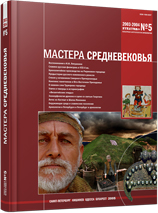Зооморфологический анализ и типология изображений дракона в сцене со святым Георгием
Zoomorphological Study and the Typology of Representation of Dragon Killed by Saint George
Author(s): Luminiţa Bejenaru, Ludmila Bacumenco-PîrnăuSubject(s): History, Cultural history, History of ideas, Middle Ages, 15th Century
Published by: Издательский дом Stratum, Университет «Высшая антропологическая школа»
Summary/Abstract: This paper aims to find a zoomorphological interpretation for the image of dragon – a widely spread image on religious objects on the territory of medieval Moldova. Dragon is a fairy creature still endowed with real morphological elements mostly borrowed from some existing reptiles such as snake and not only, as it will be seen from further analysis.Dragon is generally seen as a product of late urban culture, where as a result of weaker connection with the animal world the man mixes morphological elements of some animals with threatening and mysterious powers in his imagination: snake, predatory bird, wolf, scorpion. This paper makes use of representations which have already received professional attention. In some cases there were made some revisions, highlighting therewith some specific morphological elements. For example, the case of the dragon identified as “insect-dragon” turned to be the image of a scorpion. The analysis of morphological representation of the dragon used 3 categories of sources: flags, stamps and tiles. In the case of the first two, their official character has possibly imposed certain standards of representation of the fairy animal. Out of these, there were analyzed two flags representing the scene with St. George fighting with the dragon, flags offered by Stephan the Great (Stefan cel Mare) to Zographou monastery from the Mountain of Athos. Also studied was the image of the dragon on a big number of stamps belonging to episcopacy of Moldova whose protector St. George was, the majority of representations being simplistic variants of one common model. The tiles represent the main source of this study based on works regarding the tiles of medieval Moldova. The tiles offer a huge diversity of forms where the dragon occurs, in this case the form itself being much influenced by the subjectivity of imagination and skills of the craftsman. Thus there occur reflections of fear of different animals: snake, wolf, scorpion, but there can be also found caricature elements, such as a duck head.
Journal: Stratum plus. Археология и культурная антропология
- Issue Year: 2004
- Issue No: 5
- Page Range: 431-439
- Page Count: 9
- Language: Russian
- Content File-PDF

